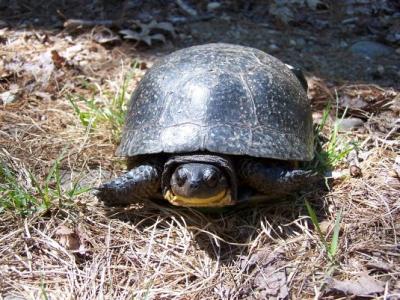Blanding's Turtle
Emydoidea blandingii
 NH Conservation Status: State Endangered, Wildlife Action Plan Species in Greatest Need of Conservation. Legally protected in New Hampshire: possession, sale, import, and take (harm, harass, injuring, killing) is illegal.
NH Conservation Status: State Endangered, Wildlife Action Plan Species in Greatest Need of Conservation. Legally protected in New Hampshire: possession, sale, import, and take (harm, harass, injuring, killing) is illegal.
State Rank Status: Critically imperiled (S1)
Distribution: Restricted to Southeastern NH
Description: A 7- to 9-inch turtle with yellow speckles that often run together to form streaks on the carapace. Easily identified when basking from its characteristic yellow throat and chin.
Commonly Confused Species: Spotted turtle; Box turtle
Habitat: Wetland habitats with permanent shallow water and emergent vegetation such as marshes, swamps, bogs, and ponds. Use vernal pools extensively in spring and while traveling through the landscape. May use slow rivers and streams as mechanisms for dispersal between wetlands. Extensive use of terrestrial habitats for nesting and travel among wetlands.
Life History: Eight to 10 eggs are deposited in sandy, loamy soils in upland areas in June. Nesting sites include disturbed soils, pastures, powerline corridors, roadsides, and yards. Hibernate in shrub swamps, ponds, and vernal pools. Blanding’s turtles use a variety of wetland and terrestrial habitats and may travel extensively among them. Therefore, a key conservation strategy for the long-term survival of Blanding’s turtles is the conservation of large undeveloped areas in southern New Hampshire.
Conservation Threats: Road mortality, Loss and/or alteration of wetland and terrestrial habitats, fragmentation, loss of nesting habitat, and increased abundance of subsidized predators.



